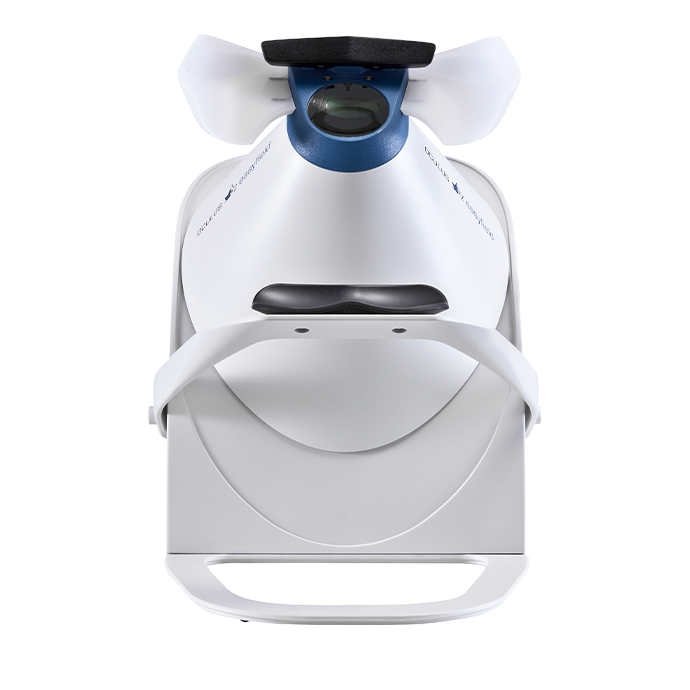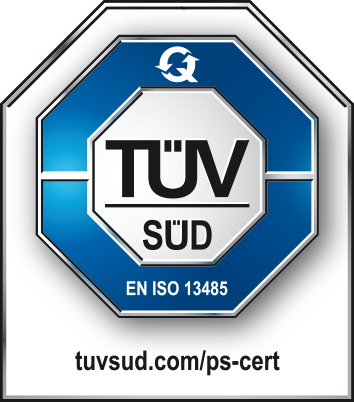Easyfield®
The OCULUS Easyfield® is the smallest full-fledged perimeter on the market. It is designed for use as a visual field screener and as a threshold perimeter for immediate re-examination of any abnormal findings. Ideal for all common examinations of the central visual field up to 30°. The Easyfield® C has an adjustable double chin rest and uses translucent eye shields for maximum patient comfort.
Advantages of the OCULUS Easyfield®:
- Fast: Enjoy shorter examination times even for threshold tests
- Streamlines workflow: Enclosed design eliminates dark room requirements
- Portable: Lightweight, minimal footprint maximizes transportability
- Durable: Well-designed and easy to service in the absence of moving parts
- Versatile: Performs more than screening with supra-threshold and threshold tests
- Comprehensive Perimetry: Enjoy advanced test strategies, unique evaluation tools, and efficient progression analysis

Functions
Ergonomic Design
One of the most striking features of the Easyfield® is its small footprint. Its compact design and light protected bowl enable examinations to be performed in rooms with normal lighting conditions. The perimeter is robust and light-weight, making it well-suited for portable use. The absence of moving device parts guarantees prolonged product lifetime.
Easy Operation
The Easyfield® perimeter is operated via an external computer (notebook or PC). You can enjoy the full freedom of networking the examination data with the familiar user interface of the OCULUS programs. The use of translucent eye shields allows you to conduct measurements without the usual eye patch, thus saving you valuable time of preparing examinations.
Increased Diagnostic Reliability
High stability test strategies like SPARK and additional assessment tools improve the diagnostic value of the Easyfield® perimeter. The enhanced Glaucoma Staging System (GSS 2) of Dr. Brusini and the Glaucoma Staging Program (GSP) expert systems offer extended support in the single field analysis. The Threshold Noiseless Trend (TNT) carries out efficient progression analysis. Examination quality is ensured by a patented fixation control algorithm, a high resolution video camera for eye monitoring and the various built-in catch trials.
Examination Programs
The Easyfield® comes with a set of predefined programs for most frequently needed examination routines of the central visual field or the macular area. The program list can be easily extended according to specific requirements by combining the available test patterns and test strategies.
OCULUS Test Strategies
As a screening unit, the Easyfield® perimeter generally uses threshold related suprathreshold examination strategies. These have the advantage of providing the examiner with a meaningful overview of the tested area despite the short examination time. Multiple test strategies are available for evaluating the accurate numeric values of the sensitivity thresholds. The OCULUS “Fast Threshold” reduces test duration by implementing clever improvements of the classic 4-2 step method. The CLIP strategy achieves a similar performance using a new type of stimulus presentation. The novel and unique SPARK strategy provides rapid and reproducible threshold measurements specifically developed for glaucoma patients.
OCULUS Test Patterns
The fixed grid of light emitting diodes of the Easyfield® perimeter allows examination of the common 30-2, 24-2 or 10-2 patterns. It is also possible to test individual hemispheres or quadrants. If necessary, any combination of individual points can be examined. The modular structure of the test programs allows for all patterns to be examined using any available standard strategy.
Results Printout
The measuring results of the Easyfield® perimeter are summarized in a standard printout. For suprathreshold tests only a single informational overview is printed, whereas for threshold examinations all clinically relevant data is shown in distinct depictions.
Videos
Easyfield® C – Automatic perimeter up to 30° eccentricity
The Software
SPARK Threshold Strategy: Enjoy Speed, Precision, and Reliability
Glaucoma Staging System (GSS 2)
Glaucoma Staging Program (GSP)
Threshold Noiseless Trend (TNT) Progression Analysis
The SPARK strategy is based on statistical relationships between threshold values found for different locations in the glaucomatous visual field. These relationships have been derived from more than 90,000 perimetric examinations, providing high statistical significance and allowing for fast and very precise threshold measurements in the central visual field. The four-phase structure of SPARK makes it a versatile tool for clinical practice:
- SPARK Precision is the full-fledged version of SPARK. Comprehensive visual field examinations of glaucoma patients can be performed in just 3 minutes per eye. Averaging the results over all four phases ensures a high degree of reliability and reproducibility for improved progression analysis.
- SPARK Quick is the perfect strategy for follow-up and screening examinations. The procedure only takes 90 seconds per eye.
- SPARK Training is ideal for patient training. This 40-second measurement can also be used for screening.
- The SPARK strategy is fine-tuned for use in clinical examinations of glaucoma patients.
The GSP software places examination findings into visual field classes (normal, glaucomatous, artifactual and neuro) based solely on their appearance. In addition, risk classes (normal, suspect, pre-perimetric, early stage, moderate and severe) are also assigned to findings that are classified as normal or glaucomatous. The evaluation results are presented in intuitive green-yellow-red color coding.
The striking novelty of the GSP is its ability to detect subtle changes in the visual field associated with early stage glaucoma. Findings of suspect and pre-perimetric risk classes may contain reductions in the visual field that cannot be readily seen by the examiner. They usually remain undetected also by standard perimetric indices.
The Glaucoma Likelihood Index (GLI) summarizes the results of the GSP classification into a single parameter presenting a value between 0 (normal) and 5 (severe glaucoma).
The Glaucoma Staging Program (GSP) is available for OCULUS Twinfield® 2, Centerfield® 2 and Easyfield® perimeters. This upgrade is available for the existing units.
- TNT creates a concise progression analysis report containing the most important parameters (MD increase, p-values, etc.).
- TNT can differentiate between diffuse and focal progression based on the focality index (FI) value.
- TNT applies multiple statistical criteria to establish possible progression.
- TNT displays the prognosis of the expected visual field for a patient age-group selected by the examiner.





Title
Description
Technical Data
| Programs | Pre-defined glaucoma, macula, screening and neurological tests User-defined tests |
| Test patterns | 30-2, 24-2, 30×24, 10-2, hemisphere, customized patterns |
| Strategies | Threshold strategies: SPARK Quick, CLIP, OCULUS Fast Threshold, Full Threshold (4/2) Optional: SPARK Precision Age adapted suprathreshold screening (2-zone, 3-zone, quantify defects) |
| Examination Speed | Adaptive, fast, normal, slow, user-defined |
| Fixation control | Through central threshold, Heijl-Krakau (using the blind spot), live video image |
| Result Display | Greyscale, dB values (absolute / relative), symbols, probabilities, 3D plot |
| Reports | Glaucoma Staging System (GSS2), Glaucoma Staging Program (GSP), Threshold Noiseless Trend (TNT) progression report |
| Perimeter bowl radius | 300 mm |
| Max. eccentricity | 30° |
| Stimulus size | Goldmann III |
| Stimulus color | White |
| Stimulus duration | 200 ms / user-defined |
| Stimulus luminance range / increments | 0.03 – 3 180 cd/m² (0.1 – 10 000 asb) / 1 dB |
| Background luminance | 10 cd/m² (31.4 asb) |
| Patient positioning | Measurement head with adjustable angle of inclination, adaptable chin rest (Easyfield® C only), double head rest |
| Software | Device control, patient management, backup, and print software (Windows®) Built-in networking, easy EMR-integration, DICOM compatibility |
| Interface | USB |
| Dimensions (W x D x H) | Easyfield® S: 274 x 370 – 470 x 314 – 429 mm (10.8 x 14.6 – 18.5 x 12.4 – 16.9 in) Easyfield® C: 316 x 506 – 540 x 320 – 435 mm (12.4 x 19.9 – 21.3 x 12.6 – 17.1 in) |
| Weight | Easyfield® S: 4.6 kg (10.1 lbs) Easyfield® C: 7.4 kg (16.3 lbs) |
| Max. power consumption | 26 W |
| Voltage, Frequency | 100-240 V AC 50 – 60 Hz |
| Recommended computer specifications | Intel® Core™ i5 (6th Generation – Current), 500 GB HDD, 8 GB RAM, Intel® HD Graphics, Windows® 10 |
Contact us!
Request a quote or contact us if you need further information.
Request a quoteContact requestHotline
Questions?
Get in touch with us.
Tel. +1 888 284-8004
